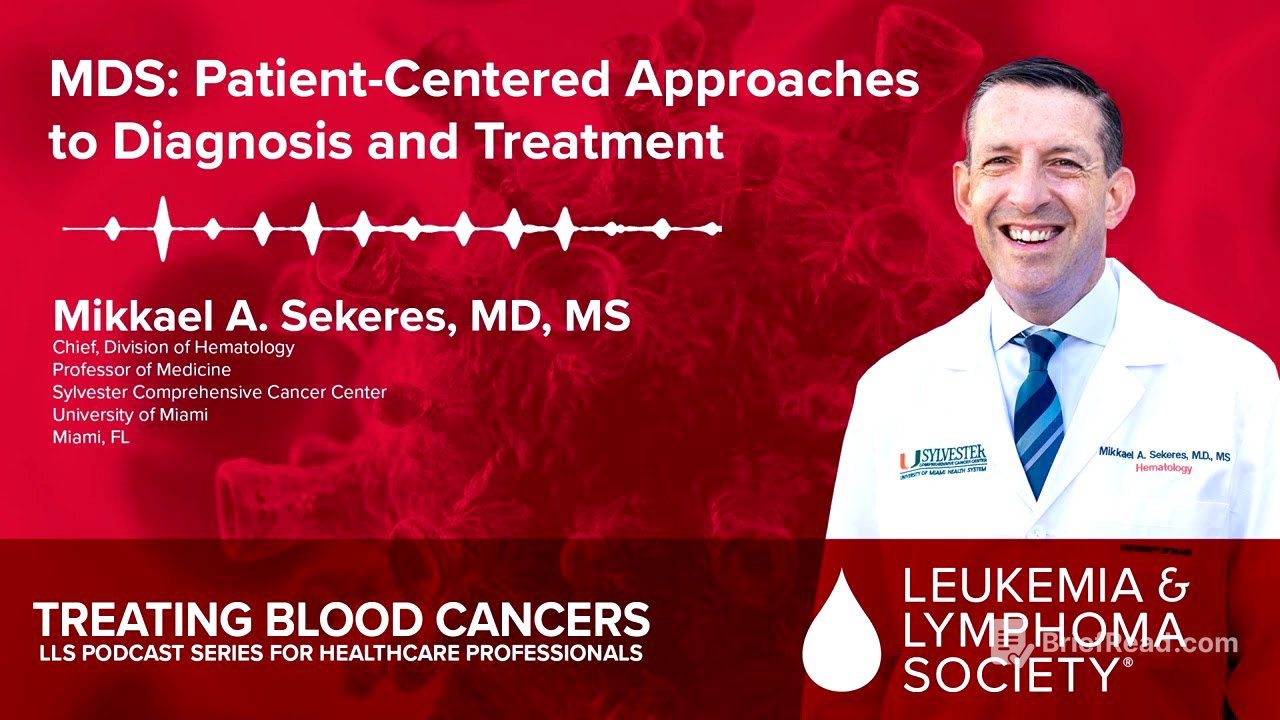TLDR;
This podcast episode features a discussion on myelodysplastic syndromes (MDS) with Dr. Mikuel Securus. The conversation covers the evolution of understanding and classifying MDS, diagnostic approaches, treatment strategies for both higher and lower-risk MDS, and the importance of patient-centered care. Key points include the reclassification of MDS as neoplasms, the role of cytopenias, blasts, and genetics in risk stratification, and the nuances of managing neutropenia in MDS patients.
- MDS is now recognized as a group of neoplasms with varying degrees of severity.
- Risk stratification involves assessing cytopenias, blast counts, and genetic abnormalities.
- Treatment approaches differ significantly based on whether the MDS is classified as lower or higher risk.
Introduction [0:00]
Dr. Ken Miller introduces the podcast episode focusing on myelodysplastic syndromes (MDS). He welcomes Dr. Mikuel Securus, a hematology expert, to discuss diagnostics, treatment strategies, patient-centered care, and side effect management in MDS. Dr. Miller also recommends Dr. Securus's book, "When Blood Breaks Down," which explores the science and personal aspects of treating leukemia patients.
Evolution of Understanding MDS [1:21]
Dr. Securus reflects on how the understanding and classification of MDS have evolved since the French American British group morphologically described it. Initially, there was hesitation in calling MDS a cancer, even among patient advocacy groups. Patients were often told they had a "blood disorder," which downplayed the seriousness of the condition. The World Health Organization (WHO) reclassified MDS as neoplasms in 2001, with subsequent updates in 2008, 2016, and 2022, emphasizing the severity of the diagnosis.
Neoplasm vs. Cancer: Communicating with Patients [3:29]
Dr. Miller and Dr. Securus discuss the difference between calling MDS a neoplasm versus cancer and how to communicate the diagnosis to patients. While "neoplasm" may seem gentler, Dr. Securus explains to patients that MDS is a clonal disorder and acknowledges the term "cancer" they may have encountered. For lower-risk MDS, he frames it as a chronic condition, while for higher-risk MDS, he emphasizes the seriousness and need for aggressive treatment. It's crucial to accurately convey the severity of the condition to ensure patients understand the necessity of the treatment.
Risk Stratification in MDS [5:44]
Dr. Securus explains the key factors in determining whether MDS is high-risk or low-risk, emphasizing that the process has become overly complicated. The primary characteristics include cytopenias (anemia, neutropenia, thrombocytopenia), blast counts, and genetic abnormalities. More cytopenias indicate worse MDS. Blast counts below 2% are considered lower risk, while higher counts suggest higher risk. Favorable genetic abnormalities include minus Y, deletion 5Q, and deletion 20Q, while unfavorable ones involve multiple mutations or abnormalities in chromosomes 7 or 3.
Molecular Abnormalities and IPSS-M [9:26]
Dr. Securus highlights the importance of next-generation sequencing panels for myeloid mutations in MDS diagnosis. Due to the complexity of molecular abnormalities, risk scores are now calculated using online tools like the IPSS-M (International Prognostic Scoring System-Molecular). This calculator considers blood counts, age, cytogenetic abnormalities, and molecular abnormalities to determine if a patient is lower or higher risk, with positive scores indicating higher risk.
Treatment Strategies for Higher-Risk MDS [11:00]
For higher-risk MDS, immediate treatment is necessary due to the high risk of transformation to acute myeloid leukemia and poor overall survival. The only level one evidence for treatment is with azacitidine, which has been shown to prolong survival in randomized trials. The goals of therapy are to extend overall survival, prevent transformation to acute myeloid leukemia, and improve quality of life.
Treatment Strategies for Lower-Risk MDS [12:16]
In lower-risk MDS, no prospective randomized trial has demonstrated that drug intervention extends survival. Therefore, the focus is on minimizing transfusions and maximizing quality of life. If a patient has a good quality of life, active surveillance may be the best approach to avoid unnecessary side effects from treatment.
Managing Anemia in Lower-Risk MDS [13:25]
Dr. Securus discusses ways to decrease transfusion burden in lower-risk MDS patients with anemia. A transfusion threshold of hemoglobin 8 is generally used. If transfusions are needed more frequently than once per month, therapy may be considered. Erythropoiesis-stimulating agents (ESAs) are often the first step, with higher doses used compared to patients with renal failure.
Role of Luspatercept in Lower-Risk MDS [16:57]
Dr. Securus discusses the use of luspatercept, which is indicated for upfront therapy in transfusion-dependent anemia with lower-risk MDS, particularly in patients with ring sideroblasts or SF3B1 mutations. Studies have shown higher transfusion independence rates with luspatercept compared to ESAs in this subgroup. For patients without ring sideroblasts or SF3B1 mutations, the choice between ESAs and luspatercept is less clear, and ESAs may be used as a first-line treatment.
Managing Neutropenia in MDS [20:23]
Dr. Securus addresses the management of neutropenia in MDS patients, noting that isolated neutropenia is relatively rare. The initial approach involves monitoring patients to determine if they have functional neutropenia. If patients have recurrent infections, prophylactic antibiotics may be introduced. Growth factors are generally avoided as they may not improve functional immune response. Hypomethylating agents may be used, with lower doses potentially being sufficient.
Evolution of MDS to Leukemia [23:50]
Dr. Securus explains the evolution of MDS to acute myeloid leukemia from a genetics perspective, noting that it occurs stochastically over years or decades. Epidemiologic evidence from atomic bomb survivors shows a higher likelihood of developing MDS decades after exposure. Biologic evidence includes germline mutations that lead to myeloid malignancies. The process involves multiple mutations, with environmental factors contributing to the progression from MDS to acute myeloid leukemia.
Immune Surveillance and Immunotherapy in MDS [26:55]
Dr. Securus discusses the role of immune surveillance in MDS, noting that patients with autoimmune conditions are more likely to develop MDS, indicating an immune dysregulation problem. However, immunotherapy and CAR-T cell therapy have not been successful in MDS, possibly because the clonal process and need for correcting or removing damaged hematopoietic cell precursors require more direct interventions like chemotherapy or hypomethylating agents.
Mechanism of Action of Demethylating Agents [28:47]
Dr. Securus explains the three ways hypomethylating agents work: unsilencing tumor suppressor genes by protecting them from methylation, acting as differentiation agents to mature immature cells, and exerting direct cytotoxic effects. The varying degrees of cytopenia observed in patients treated with these agents reflect the different mechanisms at play.
Managing High-Risk MDS: A Case Study [30:35]
Dr. Securus emphasizes the importance of maintaining the dose and schedule of hypomethylating agents during the first four to six cycles of therapy. Studies have shown that dose delays or reductions can negatively impact outcomes. Transplant is generally recommended upfront for higher-risk MDS to maximize survival, while it is reserved for later stages in lower-risk MDS.
Future Directions and Clinical Trials in MDS [34:38]
Dr. Securus discusses future directions in MDS treatment, including combination therapies and targeted therapies. He is awaiting results from a randomized trial combining azacitidine and venetoclax for higher-risk MDS. Targeted therapies like ivosidenib for IDH1-mutated MDS are also promising. He notes that SF3B1-mutated patients with ring sideroblasts may be a potential target for drugs like luspatercept.
Reflections on MDS and the Importance of Truthfulness [37:06]
Dr. Miller and Dr. Securus reflect on the progress made in understanding and treating MDS over the past 30 years. Dr. Securus emphasizes the importance of calling MDS a cancer to communicate the seriousness of the diagnosis to patients. He also shares insights from his upcoming book, which focuses on truths and fallacies in cancer, highlighting the importance of addressing misinformation and exploring patients' lives to uncover potential occupational exposures and other factors contributing to their condition.
Closing Remarks [40:08]
Dr. Miller thanks Dr. Securus for the informative discussion. He provides resources for healthcare professionals, including continuing education activities and contact information for the LLS Information Resource Center. Listeners are encouraged to subscribe to future podcast episodes and provide feedback.






![[아육톡2화] 인지학습치료가 뭐죠?!](https://wm-img.halpindev.com/p-briefread_c-10_b-10/urlb/aHR0cDovL2ltZy55b3V0dWJlLmNvbS92aS92ZGxkZUlFV3JYMC9ocWRlZmF1bHQuanBn.jpg)


